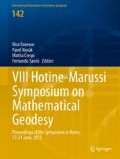Abstract
In this contribution we analyze the integrity of the GNSS array model through the so-called uniformly most powerful invariant (UMPI) test-statistics and their corresponding minimal detectable biases (MDBs). The model considered is characterized by multiple receivers/satellites with known coordinates where the multi-frequency carrier-phase and pseudo-range observables are subject to atmospheric (ionospheric and tropospheric) delays, receiver and satellite clock biases, as well as instrumental delays. Highlighting the role played by the model’s misclosures, analytical multivariate expressions of a few leading test-statistics together with their MDBs are studied that are further accompanied by numerical results of the three GNSSs GPS, Galileo and BeiDou.
Access this chapter
Tax calculation will be finalised at checkout
Purchases are for personal use only
References
Arnold SF (1981) The theory of linear models and multivariate analysis, vol 2. Wiley, New York
Baarda W (1968) A testing procedure for use in geodetic networks. Technical Report, Publications on Geodesy, New Series, vol 2, no. 5. Netherlands Geodetic Commission, Delft
Euler HJ, Goad CC (1991) On optimal filtering of GPS dual frequency observations without using orbit information. J Geod 65(2):130–143
Giorgi G, Henkel P, Gunther C (2012) Testing of a statistical approach for local ionospheric disturbances detection. In: Proceedings of the IEEE-ION Position Location and Navigation Symp (PLANS), 2012. IEEE, USA, pp 167–173
de Jonge PJ (1998) A processing strategy for the application of the GPS in networks. PhD Thesis, Publication on Geodesy, 46, Delft University of Technology, Netherlands Geodetic Commission, Delft
Khanafseh S, Pullen S, Warburton J (2012) Carrier phase ionospheric gradient ground monitor for GBAS with experimental validation. Navigation 59(1):51–60
Odijk D, Teunissen PJG, Khodabandeh A (2014) Single-frequency PPP-RTK: theory and experimental results. IAG Symp 139:167–173
Schaffrin B, Bock Y (1988) A unified scheme for processing GPS dual-band phase observations. Bull Géod 62(2):142–160
Teunissen PJG (1997) GPS double difference statistics: with and without using satellite geometry. J Geod 71(3):137–148
Teunissen PJG (1998) Minimal detectable biases of GPS data. J Geod 72(4):236–244
Teunissen PJG (2000) Testing theory: an introduction. Series on Mathematical Geodesy and Positioning. Delft University Press, Delft
Teunissen PJG (2010) Integer least-squares theory for the GNSS compass. J Geod 84(7):433–447
Teunissen PJG (2012) A-PPP: Array-aided precise point positioning with global navigation satellite systems. IEEE Trans Signal Process 60(6):2870–2881
Teunissen PJG, de Bakker PF (2012) Single-receiver single-channel multi-frequency GNSS integrity: outliers, slips, and ionospheric disturbances. J Geod 87(2):161–177
Acknowledgements
P.J.G. Teunissen is the recipient of an Australian Research Council Federation Fellowship (project number FF0883188).
Author information
Authors and Affiliations
Corresponding author
Editor information
Editors and Affiliations
Appendix
Appendix
Proof of (3)
The model’s misclosures, forming the condition equations, can be formulated through pre-multiplying the corresponding observation vector by an orthogonal complement basis matrix of the design matrix (Teunissen 2000). In case of the single-epoch ambiguity-float scenario, the carrier-phase observations are all reserved to determine the DD ambiguities, thus leaving the code observations to contribute to the redundancy of the model. Given the observations Eq. (1), the code-only design matrix A, together with its orthogonal complement basis matrix B, can therefore be expressed as (per baseline)
from which (3) follows. That the misclosures M 1 and M 2 are mutually uncorrelated follows from the identities \(D_{s}^{T}\bar{g} = D_{s}^{T}g\), and \((D_{s}^{T}g)^{\perp T}D_{s}^{T}g = 0\). □
Proof of Theorem
Equation (6) is indeed another expression of the UMPI test-statistic T q presented in Teunissen (2000). In terms of the model’s misclosures M, T q and its MDB-squared | | ∇ | | 2 read
To complete the proof, we thus need to show
The first expression follows from the trace-property tr(UV ) = tr(VU) for any matrices U and V of an appropriate size, and the fact that the trace of a scalar is equal to the scalar itself. The second expression follows from the equality between the trace of a projector and its rank, that is
since rank(C M ) = q. □
Proof of (12)
In case of the atmosphere-fixed scenario, no differential atmospheric delays are to be estimated, i.e. μ = 0 and g = 0. This yields μ ⊥ = I f and \((D_{s}^{T}g)^{\perp } = I_{s-1}\). According to (3), the frequency-difference misclosures M 1 vanishes, and the vectorized version of the atmosphere-free misclosures M 2 takes the following form
with the variance matrix (cf. (2))
Upon choosing the array-detector structure (11), matrix C M of \(M_{\tilde{p}}\), introduced in Theorem 1, reads then
Similar expressions are formulated for the carrier-phase observations \(\tilde{\varPhi }\), in case the ambiguities are fixed to their integers. The structures of \(M_{\tilde{\phi }}\), \(Q_{M_{\tilde{\phi }}M_{\tilde{\phi }}}\) and \(C_{M_{\tilde{p}}}\) are thus identical to those of \(\tilde{P}\). Substituting \(M = [M_{\tilde{p}}^{T},M_{\tilde{\phi }}^{T}]^{T}\),
an application of Theorem 1 gives (cf. (6))
The proof follows then from
and
with the projectors \(P_{e_{s}}^{\perp } = W_{s}^{-1}D_{s}(D_{s}^{T}W_{s}^{-1}D_{s})^{-1}D_{s}^{T}\), and \(P_{D_{n}} = D_{n}(D_{n}^{T}D_{n})^{-1}D_{n}^{T}\).
The proof of(14), (17), (19)and(21)goes along the same lines as the proof of(12). □
Rights and permissions
Copyright information
© 2015 Springer International Publishing Switzerland
About this paper
Cite this paper
Khodabandeh, A., Teunissen, P.J.G. (2015). Single-Epoch GNSS Array Integrity: An Analytical Study. In: Sneeuw, N., Novák, P., Crespi, M., Sansò, F. (eds) VIII Hotine-Marussi Symposium on Mathematical Geodesy. International Association of Geodesy Symposia, vol 142. Springer, Cham. https://doi.org/10.1007/1345_2015_64
Download citation
DOI: https://doi.org/10.1007/1345_2015_64
Publisher Name: Springer, Cham
Print ISBN: 978-3-319-24548-5
Online ISBN: 978-3-319-30530-1
eBook Packages: Earth and Environmental ScienceEarth and Environmental Science (R0)

